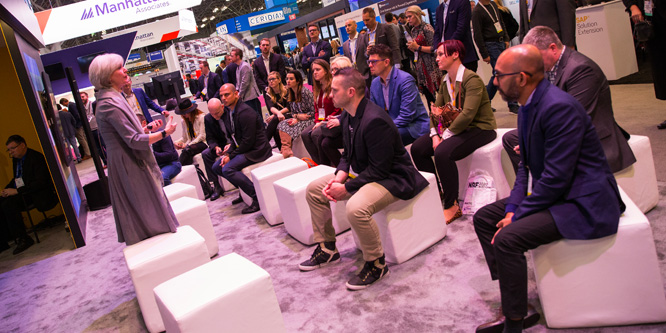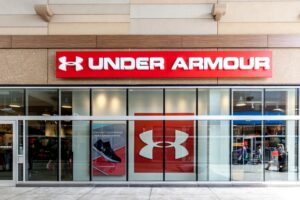
Photo: NRF
January 30, 2020
Will 2020 be the year of less flash and more substance for in-store tech?
At the NRF Big Show this year, one could say there was a more sobering mood to technology adoption by retailers. While the need to constantly innovate is no less present in 2020 than in recent years, many attendees and speakers spoke about achieving more practical use cases in deployments of new technology in stores and realizing tangible results.
Hudson’s Bay Company CEO Helena Foulkes noted during a session about fueling future growth on the main stage, “We can all have dreams and vision, but we have to execute and produce results.”
Taking a global retail perspective during a panel discussion session on the impact of technology in the physical world, Dimas Gimeno, chairman of Skintelligence Investments S.L. and former president of El Corte Inglés, told the audience, “Technology is not the solution. It is the tool that, if used right, will help you develop the solution. It’s not about giving your sales staff an iPad.”
Leading to a discussion of enabling store associates with technology, panel members gave examples of how they measured improvements in customer experience and impact on in-store sales.
Thomas Andrews, group partnerships at Carrefour, indicated that for every point increase in Net Promoter Score (NPS) they see a 20 million euro jump in store sales. The retailer operates a live lab store in Paris where employees and guests can shop while experiencing various new technologies, including a cashier-less checkout. As technologies prove themselves in the live Carrefour lab store, they “graduate” to being deployed to production stores.
In recent years at the NRF Big Show, vendors offered only “what if” ideas of how technologies could be used to drive innovation along with the loosely defined desire to enhance the in-store customer experience, but this year seemed more focussed.
When it came to two of the most prevailing technologies, artificial intelligence and computer vision, vendors displayed clear examples of retailer deployments and demonstrated use cases highlighting the expected ROI from those solutions.
Numerous vendors showed versions of a cashier-less experience similar to Amazon Go stores with an emphasis on the ROI these solutions could bring the retailer in terms of sales and data insights, not just how they improve the customer experience by removing friction.
Discussion Questions
DISCUSSION QUESTIONS: How should retailers balance the drive to constantly innovate to improve the customer experience with the need for proven ROI? Are you seeing a growing desire among retailers to return to business basics in applying new tech to stores?
Poll
BrainTrust
Sterling Hawkins
Co-founder, CART
Dr. Stephen Needel
Managing Partner, Advanced Simulations
Recent Discussions







The Carrefour case study Ricardo cites in the article says it all: a 20 million Euro revenue lift for every one-point lift on their NPS score. We heard this same refrain from dozens of customers at NRF: Store tech investments must be evaluated against how they impact the customer, whether within the shopping journey or capturing insights that enable better customer decisions.
The answer to the headline question is “absolutely not” — most in-store tech is nothing but flash. Sizzle but no steak — at least until retailers learn how to cook. In other words, until retailers are truly in a position to make rigorous data-driven decisions about which tech elements to use for which customers and under which circumstances — and to make rigorous data-driven evaluations of these activities as they perform them — then they’re wasting a lot of time, effort, and money. That’s the harsh reality, and too many retailers will only learn this the hard and painful way…
Flash is in the retail DNA and has been forever. It will be the #1 problem with retailers moving forward. Small retailers and large ones look for the silver bullet, that flash, and ignore substance. Even in tech, they will choose flash over substance. I don’t see that changing in 2020.
In a store environment in particular, the human touch is essential. For technology to be of benefit it must free up the time of customer-facing in-store teams to spend time with customers. It may well be that the impact of this cannot be seen in a traditional ROI calculation.
Retailers are starting to (re)discover that their people are a key differentiator to the overall experience so anything that gets in the way of this becomes a distraction. Criteria to consider when investing could be ensuring you ask questions like: Is it cheaper for the retailer? Does it make it easier for the customer? Does it get in the way of the associate spending time with the customer?
First retailers should abandon the idea that they need to constantly innovate. They constantly need to keep tabs on the customer experience – sometimes a tech solution helps, sometimes it’s a human solution. No retailer should ever employ technology that hasn’t been shown to improve ROI and the customer experience.
I think it boils down to a couple of simple questions. What is scalable NOW — and what will produce a reasonable ROI? What has been tested and proven? What has become competitive table stakes? What else is out there in test mode? What should I be testing that is most relevant to my specific business? With a finite budget, is some element of tech really my top priority investment? Or should I be investing in product development, or marketing, or staff training or…? I think Dimas has a very healthy perspective!
For years, retailers believed that they needed to invest in all kinds of technology or the competitors would put them out of business. Ironically, so many of the articles published talking about the need and the high customer demand for various technologies were written by the tech companies themselves. Now, after years of spending money, retailers realize they’ve been duped. Yes we need technology, but as Dimas Gimeno said, it’s a tool, not a solution, and every retailer needs to find where that tool fits into enhancing their business and the customer experience.
I am all for using the latest technology to help run a business (I am a big believer in AI technology) however, I also know that there is an overwhelming amount of technology out there. It all comes down to what the ROI is and how long it will take to implement, especially if you are still in the Fred Flintstone world of technology. I believe a retailer has to adopt a crawl, walk, run approach in order to be successful. At the end of the day, we still have to take care of the business. This does not change.
We are at the dawn of an era where AI, cognitive intelligence and machine learning will power merchandising, assortment planning and other essential retail operations. However from what we have seen, the in-store technologies that are supposed to enhance the customer experience are more flash than substance at this point.
Retailers should not only focus on the foundational elements of retail merchandising, but formulate a clear strategy around how to respond to the emergence of purpose-driven consumption, particularly around sustainability, transparency, and wellness.
Retailers need to innovate. But the hypothesis for investments in innovation need to be supported by data, desired outcomes and rigorous ROI models. Innovation investments could be in people, infrastructure, process improvements, policy changes and technology- With technology being one of the pieces, albeit an important enabler. Technology-focused innovations without enough business context tend to end up as technology for the sake of technology.
I sure hope they will return to the basics, rid themselves of the silos of technology, process and organization that plague retail and move to a real-time cloud based “platform” to change the customer journey.
As mentioned above, for every point increase in Net Promoter Score (NPS), Carrefour sees a 20 million euro jump in store sales. That is huge, and being able to interact with the customer in real time with marketing, sales, inventory, and pricing will give retailers the opportunity to change the journey, increase customer satisfaction and beat Amazon at their own real time game. Stores need to be connected in real time, not have their sales, inventory and customer information retrieved tonight and reviewed tomorrow. You can’t win the game today by looking at it tomorrow when the game is over.
I don’t know if it’s so much a return to basics as it is a maturity in the tech. With maturity comes an ability to embrace and appreciate the subtle and effective. Four years ago we saw flashy robo-automated presentations representing the future of where the industry is headed and the reality is that now that AI, ML, and the seamless shopping experience are in practice, it looks less flashy than the lights and glitter we originally saw at NRF.
Besides, flash is relative. Flash for me is seeing sexy ROI numbers.
Technology has always been at its best when it is business driven and not technology for the sake of it. However, with new groundbreaking technology there has to be someone who is brave enough to see if it can deliver a business benefit, otherwise there would never be any customer success stories on which the followers can base their decision. Sometimes fortune does favor the brave, provided there are good sound business reasons for deploying the technology.
I do think retail executives are starting to look at technology solutions much more skeptically – and rightfully so. Many of the discussions I have with executives are about getting back basics and I see this as a positive sign. But it’s still an uphill battle because of the urgency/pressure to deliver positive financial outcomes that many retailers are struggling to consistently deliver. Retailers can be very successful by focusing on a few critical priorities and doing them well.
The “need to innovate” is a self-imposed rule from retail, but its implementation has delivered minimal benefit, while taking the focus off the customer. Retail has for too long been focused on technology in search of a problem to solve, rather than identifying the problem and then looking for a tool to address it.
The yin and yang of being a 21st-century retailer. “Every retailer is doing it, so we need to do it too.” Resulting in visionless, superficial viewpoints under the guise of innovation. So much noise! Being a retailer is not easy and never has been. Today “selling stuff” requires huge-picture thinking. In fact the product seems to be lost in many retail calculations, stymied by the call of the “customer experience” and the customerless scorecard of ROI. So what to do? Back to business basics in applying new tech in stores? Balance CX with ROI? These reflections seem to miss the point. There is no back to “business basics” in a digital world. Retail leadership might think about taking the plunge of finally “getting under the hood” of retail tech to understand firsthand that there is no such thing anymore as going back to business basics.
It’s widely recognized that customer service will be the key differentiator from most brands but particularly those with a retail presence. Given that, the need for technology that makes a substantive difference in improving the employee experience cannot be understated. From my vantage point, much of the tech deployed on the sales floor has been about pumping up sales velocity. If we are in the age of customer service, then more attention must be paid to technology that helps frontline personnel – the face of the company, as it were – to make the customer experience superb. Several studies show if the face customers are dealing with does not provide a pleasant buying experience, they’ll take their business elsewhere.
I think it’s a sequence issue. The correct sequence is to properly identify a high value business problem whose solution will provide ROI and improved customer service. That is value creation. The second step is to identify the technology that can solve the problem. Sometimes retailers (encouraged by tech vendors) are in the mode of identifying the shiny objects first. In an era with a tight labor supply, high turnover, and a significantly more informed consumer, there is no question that the right technologies can improve retailer competitiveness.
More widespread adoption of proven technologies will continue to take place. A piece of technology may lose its luster after it becomes more common, however that doesn’t mean it is not advanced. As an example, take a look at the capabilities of today’s smartphones. Pretty incredible if you look back 10 years.
Retailers need to do both – innovate and provide a return to the business. Some technology may reduce the retailer’s costs, some may increase productivity, and yet other technology may grow sales through customer service enhancements. The challenge is to test the technologies in close to a real environment so that the benefits can be measured and projected versus the cost required to implement. Like the Gartner Technology Hype Cycle, every technology eventually must provide value to the retailer before it is broadly implemented, and retailers will be returning to business basics to justify the technology’s value.
Flash and substance are not mutually exclusive; the best tech implementations have elements of both. There’s an easy way to spot the components: how does it make you feel as a customer (flash) and what results is it driving (substance). There has definitely been a trend towards more flash as emerging technologies make so much newly possible. Smart retailers are looking under the hood to be sure they are driving real results.
Retailers are risk-adverse — it usually takes a documented tangible success story from an industry leader to move the needle on adoption.